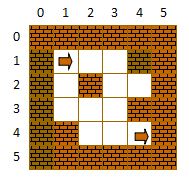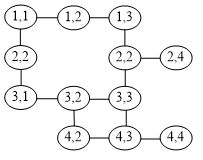/*
* Copyright (c) 2016, 烟台大学计算机与控制工程学院
* All rights reserved。
* 文件名称 :1.cpp
* 作 者 :杨俊杰
* 完成日期 :2016年 11月18日
* 版 本 号 :v1.0
* 问题描述 :
* 输出描述 :
*/
设计一个程序,采用深度优先遍历算法的思路,解决迷宫问题。
(1)建立迷宫对应的图数据结构,并建立其邻接表表示。
(2)采用深度优先遍历的思路设计算法,输出从入口(1,1)点到出口(M,N)的所有迷宫路径。
[模型建立]
将迷宫中的每一格作为一个顶点,相邻格子可以到达,则对应的顶点之间存在边相连。
例如,下面的迷宫

在使用数组表示时,用0表示格子是空地,用1表示格子处是墙,对应的矩阵是:
int mg[M+2][N+2]= //迷宫数组
{
{1,1,1,1,1,1},
{1,0,0,0,1,1},
{1,0,1,0,0,1},
{1,0,0,0,1,1},
{1,1,0,0,0,1},
{1,1,1,1,1,1}
};
- 1
- 2
- 3
- 4
- 5
- 6
- 7
- 8
- 9
- 1
- 2
- 3
- 4
- 5
- 6
- 7
- 8
- 9
建立的图结构为:

于是,从(1,1)到(4,4)的迷宫问题,转化为寻找顶点(1,1)到顶点(4,4)的路径的问题。
- #include <stdio.h>
- #include <malloc.h>
- #define MaxSize 100
- #define M 4
- #define N 4
- //以下定义邻接表类型
- typedef struct ANode //边的结点结构类型
- {
- int i,j; //该边的终点位置(i,j)
- struct ANode *nextarc; //指向下一条边的指针
- } ArcNode;
- typedef struct Vnode //邻接表头结点的类型
- {
- ArcNode *firstarc; //指向第一条边
- } VNode;
- typedef struct
- {
- VNode adjlist[M+2][N+2]; //邻接表头节点数组
- } ALGraph; //图的邻接表类型
- typedef struct
- {
- int i; //当前方块的行号
- int j; //当前方块的列号
- } Box;
- typedef struct
- {
- Box data[MaxSize];
- int length; //路径长度
- } PathType; //定义路径类型
- int visited[M+2][N+2]= {0};
- int count=0;
- void CreateList(ALGraph *&G,int mg[][N+2])
- //建立迷宫数组对应的邻接表G
- {
- int i,j,i1,j1,di;
- ArcNode *p;
- G=(ALGraph *)malloc(sizeof(ALGraph));
- for (i=0; i<M+2; i++) //给邻接表中所有头节点的指针域置初值
- for (j=0; j<N+2; j++)
- G->adjlist[i][j].firstarc=NULL;
- for (i=1; i<=M; i++) //检查mg中每个元素
- for (j=1; j<=N; j++)
- if (mg[i][j]==0)
- {
- di=0;
- while (di<4)
- {
- switch(di)
- {
- case 0:
- i1=i-1;
- j1=j;
- break;
- case 1:
- i1=i;
- j1=j+1;
- break;
- case 2:
- i1=i+1;
- j1=j;
- break;
- case 3:
- i1=i, j1=j-1;
- break;
- }
- if (mg[i1][j1]==0) //(i1,j1)为可走方块
- {
- p=(ArcNode *)malloc(sizeof(ArcNode)); //创建一个节点*p
- p->i=i1;
- p->j=j1;
- p->nextarc=G->adjlist[i][j].firstarc; //将*p节点链到链表后
- G->adjlist[i][j].firstarc=p;
- }
- di++;
- }
- }
- }
- //输出邻接表G
- void DispAdj(ALGraph *G)
- {
- int i,j;
- ArcNode *p;
- for (i=0; i<M+2; i++)
- for (j=0; j<N+2; j++)
- {
- printf(" [%d,%d]: ",i,j);
- p=G->adjlist[i][j].firstarc;
- while (p!=NULL)
- {
- printf("(%d,%d) ",p->i,p->j);
- p=p->nextarc;
- }
- printf("\n");
- }
- }
- void FindPath(ALGraph *G,int xi,int yi,int xe,int ye,PathType path)
- {
- ArcNode *p;
- visited[xi][yi]=1; //置已访问标记
- path.data[path.length].i=xi;
- path.data[path.length].j=yi;
- path.length++;
- if (xi==xe && yi==ye)
- {
- printf(" 迷宫路径%d: ",++count);
- int k;
- for ( k=0; k<path.length; k++)
- printf("(%d,%d) ",path.data[k].i,path.data[k].j);
- printf("\n");
- }
- p=G->adjlist[xi][yi].firstarc; //p指向顶点v的第一条边顶点
- while (p!=NULL)
- {
- if (visited[p->i][p->j]==0) //若(p->i,p->j)方块未访问,递归访问它
- FindPath(G,p->i,p->j,xe,ye,path);
- p=p->nextarc; //p指向顶点v的下一条边顶点
- }
- visited[xi][yi]=0;
- }
- int main()
- {
- ALGraph *G;
- int mg[M+2][N+2]= //迷宫数组
- {
- {1,1,1,1,1,1},
- {1,0,0,0,1,1},
- {1,0,1,0,0,1},
- {1,0,0,0,1,1},
- {1,1,0,0,0,1},
- {1,1,1,1,1,1}
- };
- CreateList(G,mg);
- printf("迷宫对应的邻接表:\n");
- DispAdj(G); //
- PathType path;
- path.length=0;
- printf("所有的迷宫路径:\n");
- FindPath(G,1,1,M,N,path);
- return 0;
- }
运行结果:






















 304
304

 被折叠的 条评论
为什么被折叠?
被折叠的 条评论
为什么被折叠?








